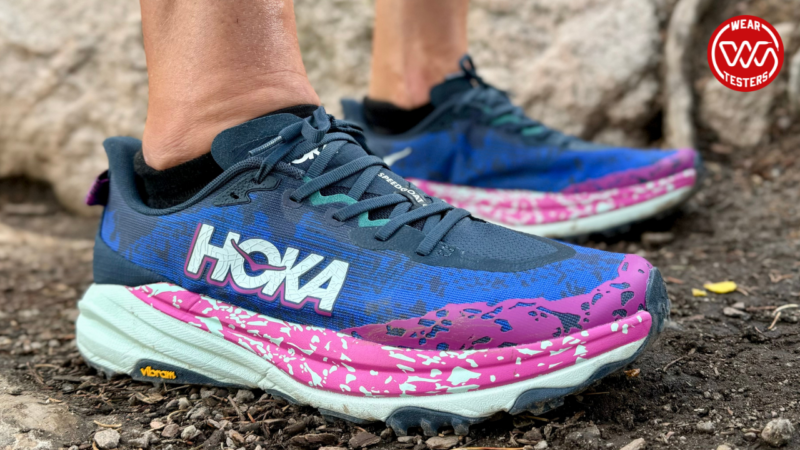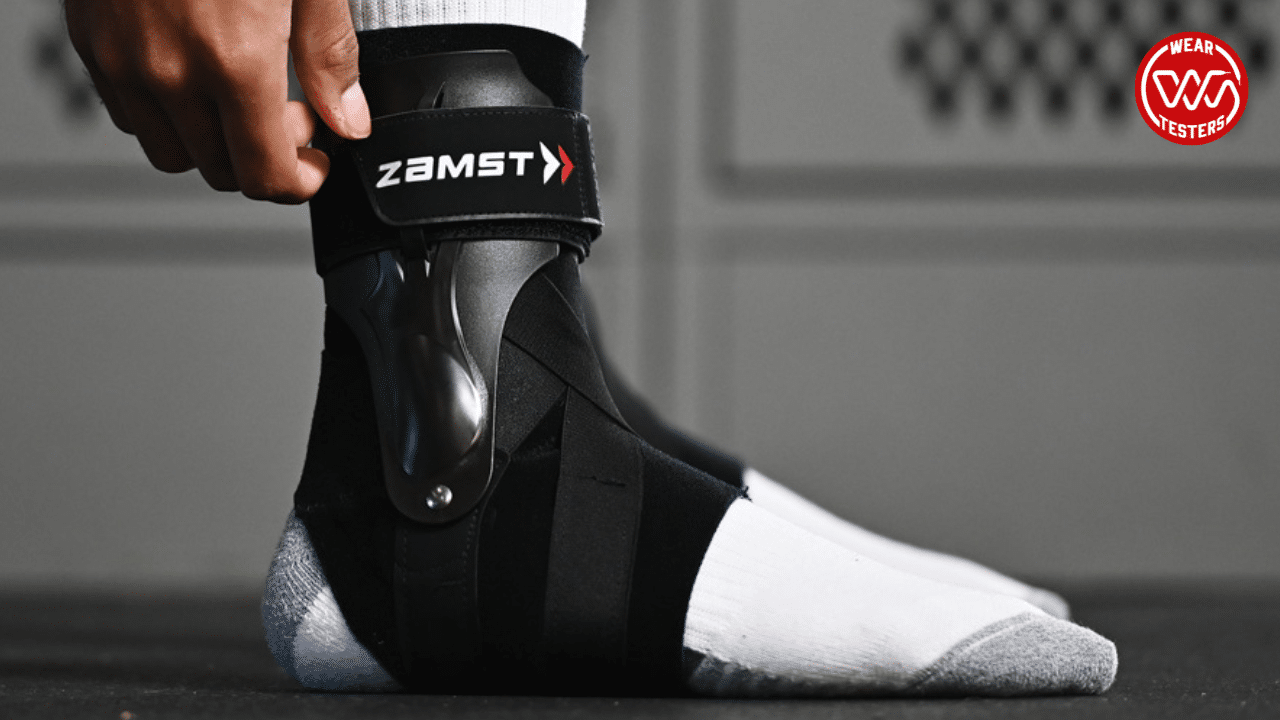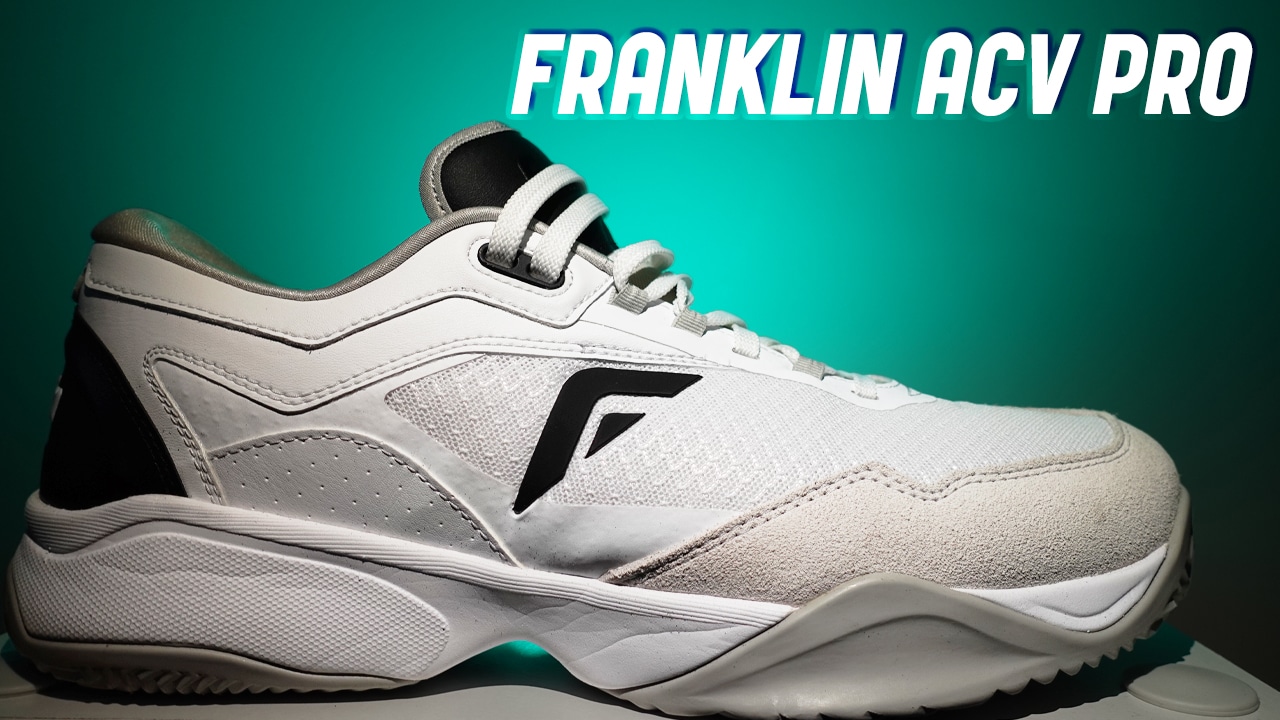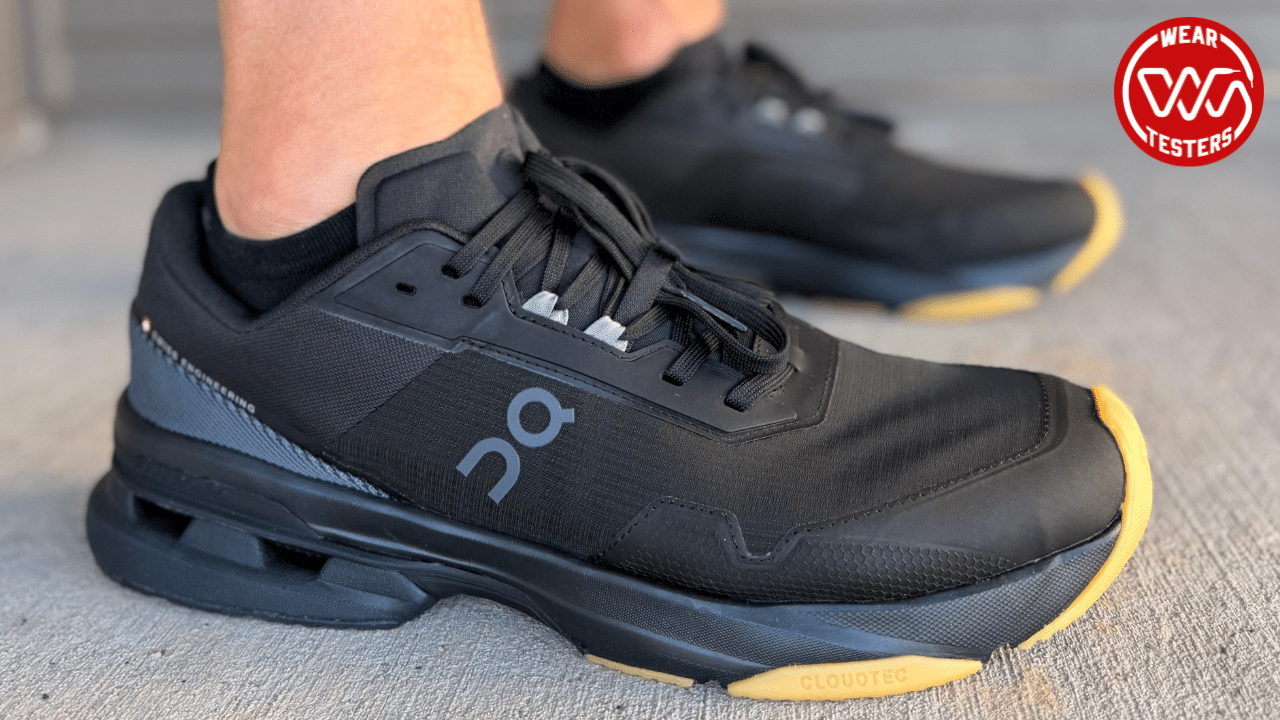As a long time user of Hoka’s Speedgoat series, the Speedgoat 5 was one of the biggest gear let downs I’ve ever experienced. Compared to the Speedgoat 4, one of the best trail shoes ever, the Speedgoat 5 was a major collapse. I’ve encountered many Speedgoat loyalists in disbelief (though some reviewers did like it). The shoe lost so much of its effectiveness. So, with renewed hope, and some trepidation, the Hoka Speedgoat 6 arrived at my door.
Hoka Speedgoat 6
Release Date: July 15, 2024
Price: $155
Weight: Men’s 9.8 oz., Women’s 8.2 oz.
Drop: 5mm
Sizing: True to size
- Rundown: The Hoka Speedgoat 6 receives a much-needed improvement in durability, underfoot feel, and fit. The direction of this legendary shoe is back to what made it great: reliability and adaptability. Is that enough?
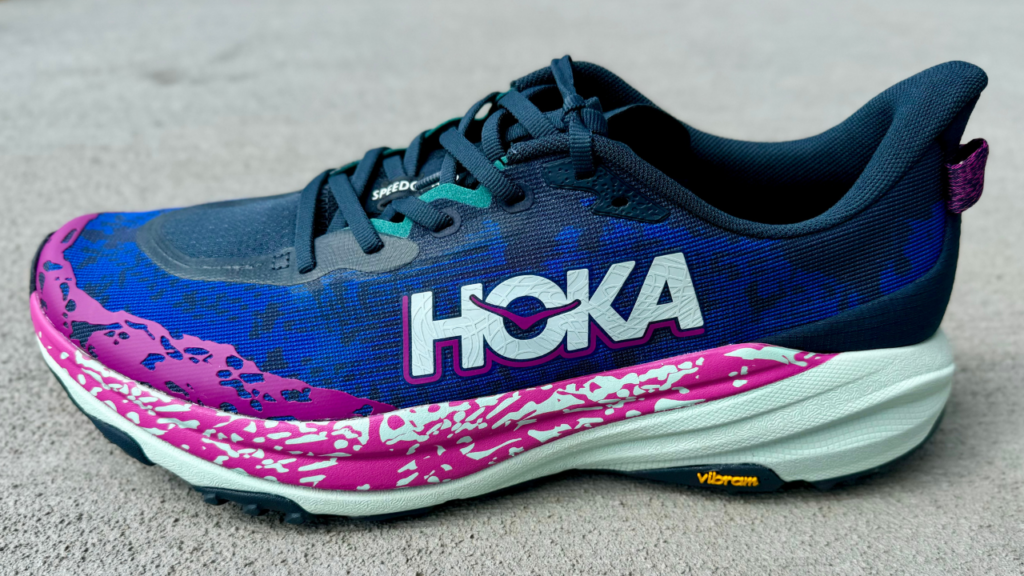
Midsole
Sam: Fortunately, Hoka redeemed itself with an updated CMEVA midsole for the Speedgoat 6. The Speedgoat 5 was great out of the box, but after only 50 miles or so, the midsole lost almost all its character.
The updated midsole on the Hoka Speedgoat 6 is a similar CMEVA formula, but much stiffer and firmer underfoot. I will say, maybe a tad too stiff, as if Hoka understood the flimsiness of the 5 and went completely opposite for the 6. Out of the box the shoe is stiff and rigid, almost to the point of discomfort.
Over the course of 30-50 miles, the midsole should start to soften up and feel like a traditional Speedgoat ride. I find myself enjoying the miles more as I continue to put miles on the shoe. It’s a cush ride while maintaining rigidity for a slightly snappier feel than the line has historically had.
I feel quite stable in the Hoka Speedgoat 6, an ode to the updated midsole. No breaking down or steps that feel like you’re running on an old mattress (I’m looking at you, Speedgoat 5). Instead there’s a solid base that’s reliable for many miles. It’s a step back closer to Hoka’s reputation as a cushioned workhorse, particularly as it pertains to the Speedgoat line. Stability and reliability will take you far. I’m happy to say that Hoka returned to those cornerstones with the Speedgoat 6.
The one thing I felt this shoe lacked in the midsole department was the characteristic comfortability we’ve come to expect from past Speedgoats. Not to say the shoes are uncomfortable, I enjoy them for the most part! I’m just not shouting from the rooftops about it.
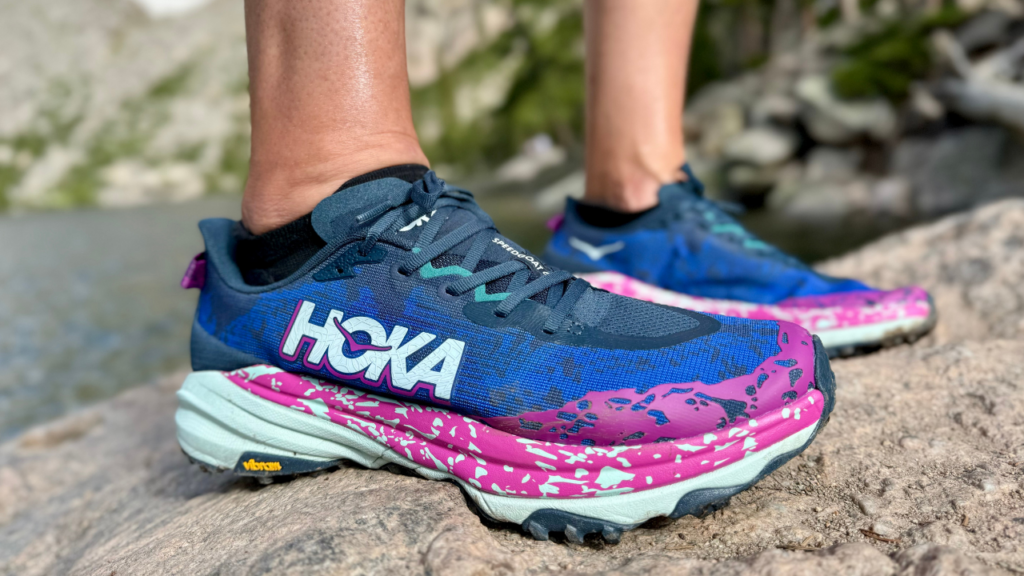
Drew: While Sam is the Speedgoat historian, this is my first Speedgoat experience. And well, it’s a forgettable experience for the first 20ish miles. Firm underfoot, stiff all around the foot. Yuck. I was ready to give up on the Hoka Speedgoat 6. But, alas, I review shoes for a living, so I kept going.
I even trekked to Utah to run UTMB’s Speedgoat 28k (which was more of a 32k but that’s another story) to wear the Speedgoat 6 in the race created by the Speedgoat. For those that don’t know, the Speedgoat series from Hoka is a signature shoe series. It’s named for Karl Meltzer, a runner that has won more 100-mile ultramarathons than any other ultramarathoner. He’s basically the GOAT of trail running (though he has competition from Courtney Dauwalter).
As part of his illustrious career, the Utah-based trail runner created a race in his home state at Snowbird Mountain Resort. And, it’s one of the hardest trail races in the United States. It was also my very first trail race (Editor’s Note: what kind of idiot chooses the most difficult trail race for his first one?).
My poor decision making aside (Editor’s Note: great job helping us trust your opinion on shoes), wearing the Speedgoat in the Speedgoat was so meta I had to do it.
As I started the race, the Hoka Speedgoat 6 was still a chore to wear but as I (slowly) made my way up a mountain, it finally softened up a bit. While it didn’t feel like a dream under my 6’6″, 195 pound frame, it felt good enough that I wasn’t hating every step. Uphill it felt well cushioned and blunted the impact of most rocks underfoot. Downhill, my size and how hard I hit the ground was a bit more than the Speedgoat 6 could handle.
But I finished the race in one piece and largely enjoyed the experience…though the 6,500 feet of elevation gain tested both my legs and mind immensely. I felt 100% stable the entire race, even crossing sections of snow and (lots of) loose rock. And alongside the traction, which we’ll talk about later, the stability of the Hoka Speedgoat 6 is its greatest asset. For all the technical trails the Speedgoat 28k included, I never had to worry about rolling over the edge of the shoe and losing my balance. That dependability goes a long way when traversing mountain ridges.
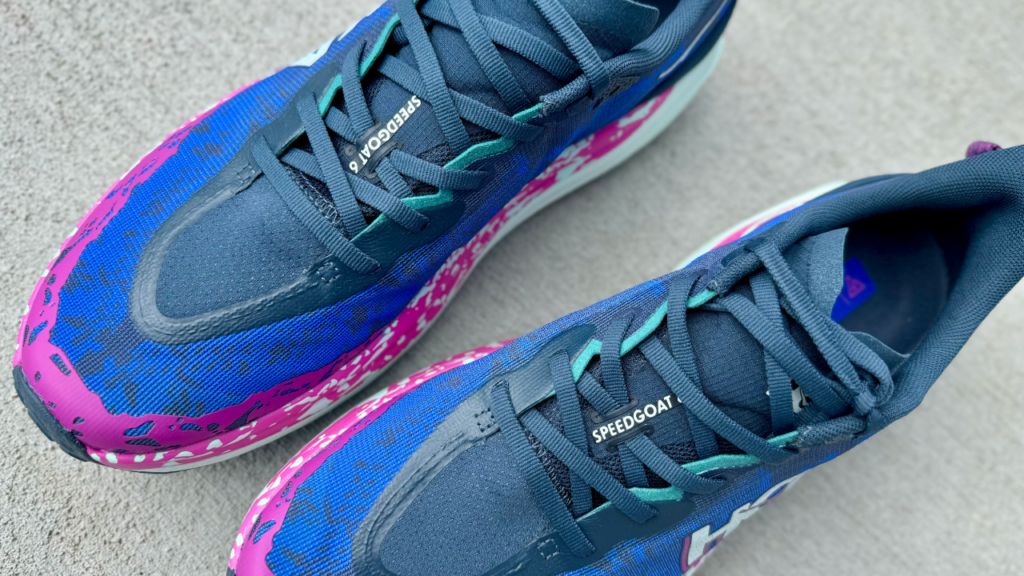
Upper
Sam: Another Speedgoat 5 gripe: the upper almost immediately started to stretch and deteriorate upon use, leading to an uncomfortable and flimsy fit. To its credit, Hoka also addressed this issue with an engineered mesh upper that holds the foot shape much better without giving too much. The mesh drains pretty well and isn’t too hot, or so I’ve found on the dry summer trails of Salt Lake City. So, the durability of the upper was much improved for the Hoka Speedgoat 6!
The fit is where I had a few issues. The stiffness of the toe box has been a bit rough on my toes. The shoe is slightly narrow, but opens up in the forefoot, which I liked. I’ve had trouble finding a method to reduce friction on my toes. The lacing on this shoe, which is similar to the Speedgoat 5, is so confusing.
For the second shoe in a row, Hoka made a tongue (padded which is nice!!) that is too short. If you use the top eyelets, the lace will most likely cause some discomfort on the top of your foot. I just don’t understand this piece of the shoe, as it seems like such an easy fix and hard to miss. Maybe it’s just my foot.
The heel is padded and nice. I haven’t found my foot slipping out of the back. Overall, an improvement in the upper. The fit just needs some work.
Drew: Contrary to Sam, I found the fit and the upper to be well-rounded. True, the tongue was too short and also true, the Speedgoat likes to friction-ize the toes, but other than that I felt well protected. I also had enough room everywhere I needed…especially in the toebox. This upper is built to handle most wide footers in addition to regular or narrow footers. Cinching the laces down doesn’t cause much bunching and wraps the foot well even if your foot doesn’t fill out the entire width of the shoe.
I didn’t love that Hoka sent the shoe laced in a configuration that features the laces descending into the lace loops instead of ascending out of them. While this configuration helps with laces loosening throughout the day, it’s hell to get them to the proper tightness. I’d recommend re-lacing the Speedgoat 6 once you get it.
The vinyl toecap fused to the upper does its job and prevented me from getting speedbagged by an insane number of rocks on the trail. While the toecap may be part of the reason for the excess toe friction, it’s necessary to save your toes from more serious blunt force trauma.
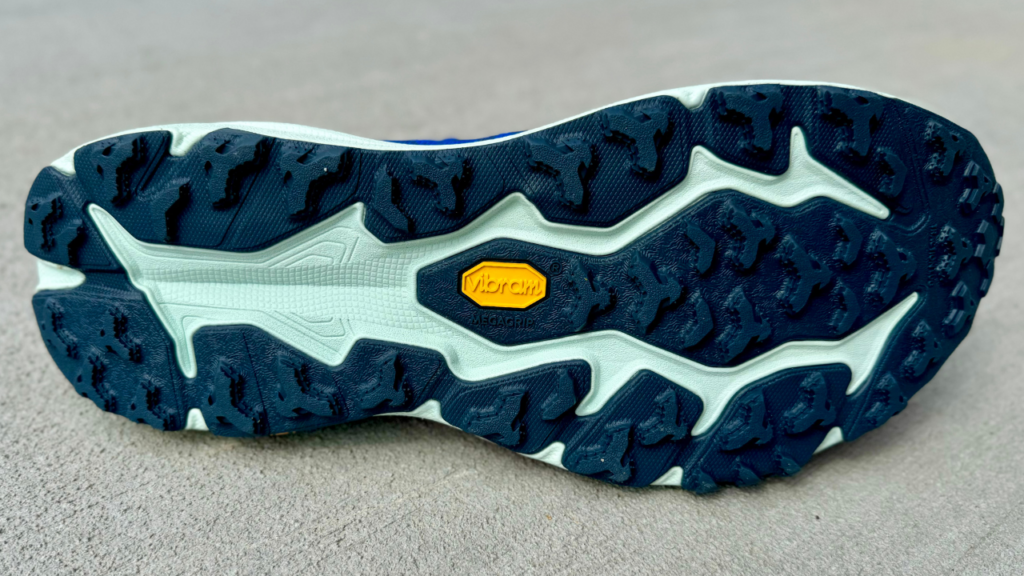
Outsole
Sam: Once again, completing the trifecta, the design team revamped the Hoka Speedgoat 6 with a new outsole and lug pattern. Vibram rubber with ~5mm lugs offers a super grippy and solid base. If you used the Speedgoat 5, you probably noticed a significant decrease in outsole after only 50-100 miles or so. The same can’t be said for the Speedgoat 6, whose outsole has been beefed up and holds true to Hoka’s reputation. The lug pattern offers Vibram’s Megagrip and has been great on all trails for me.
Coupled with an updated midsole that’s comfy enough to support long days, this recipe creates a shoe similar to the one that rocketed the Speedgoat into mainstream success. You can have long days covering almost any terrain with this shoe. It’s a true workhorse.
Drew: The Hoka Speedgoat 6 and its Vibram outsole are champs on any and all terrain. Even plunging down steep declines with only highly slanted granite-like rocks as stepping stones, the Speedgoat 6 held true. The traction was so dependable I could descend as fast as my stamina made possible. I was highly confident each step would land and stick.
I only fell once wearing the Hoka Speedgoat 6 and it was because I didn’t pick my foot up enough to clear a half-buried rock. I would have gone down like the Titanic but my other foot gripped the dirt nicely and helped me catch myself before fully going to the ground.
The peace of mind the Hoka Speedgoat 6’s traction provides is elite and in the top tier of trail shoes.
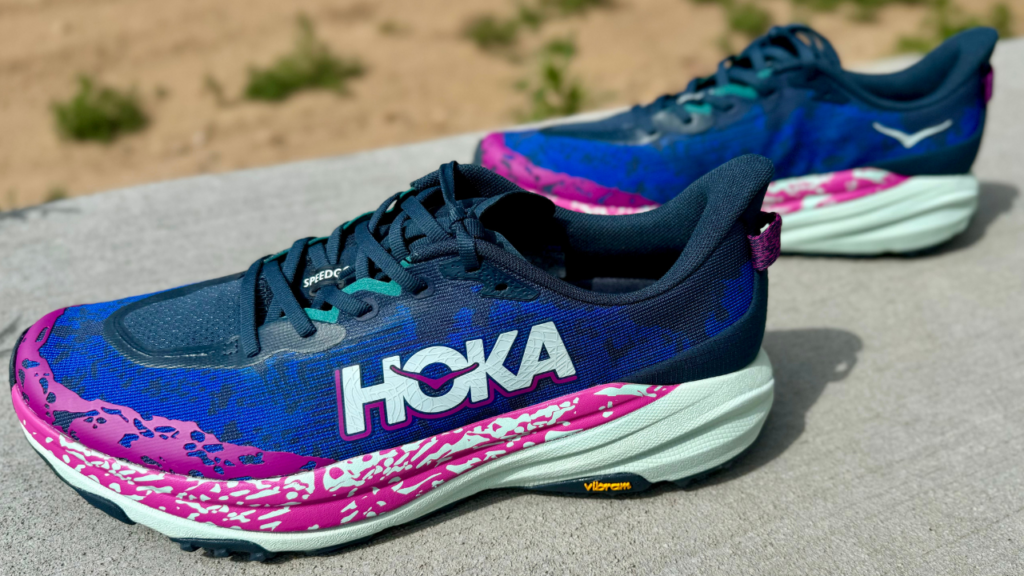
Is the Hoka Speedgoat 6 wide foot friendly?
Sam: The Hoka Speedgoat 6 is a more narrow shoe. The toe box does have some room, though, so if your shape is skinnier in the midfoot but wider towards the forefoot, you should be fine. As a caveat, Hoka offers a 2E Wide version of the shoe.
Drew: To me, the Hoka Speedgoat 6 had plenty of room but wide footers will want to go with the wide version just in case. Better to be safe because the midfoot does narrow to improve lockdown and stability.
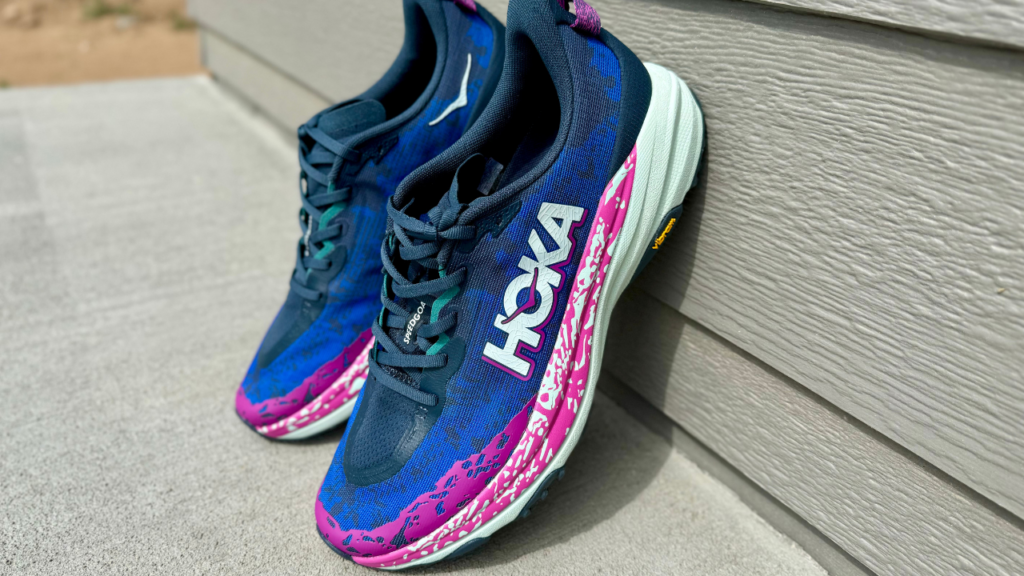
Is the Hoka Speedgoat 6 worth $155?
Sam: Yes. The Hoka Speedgoat 6 is a solid shoe where the updates make it worth the price (again).
Drew: Yes. If you value traction and stability as the premiere features on your trail shoes, the Hoka Speedgoat 6 will be worth the price. However, if you want more cushion underfoot or a rock plate, you’ll want to look at our list of the Best Trail Running Shoes for some different options.
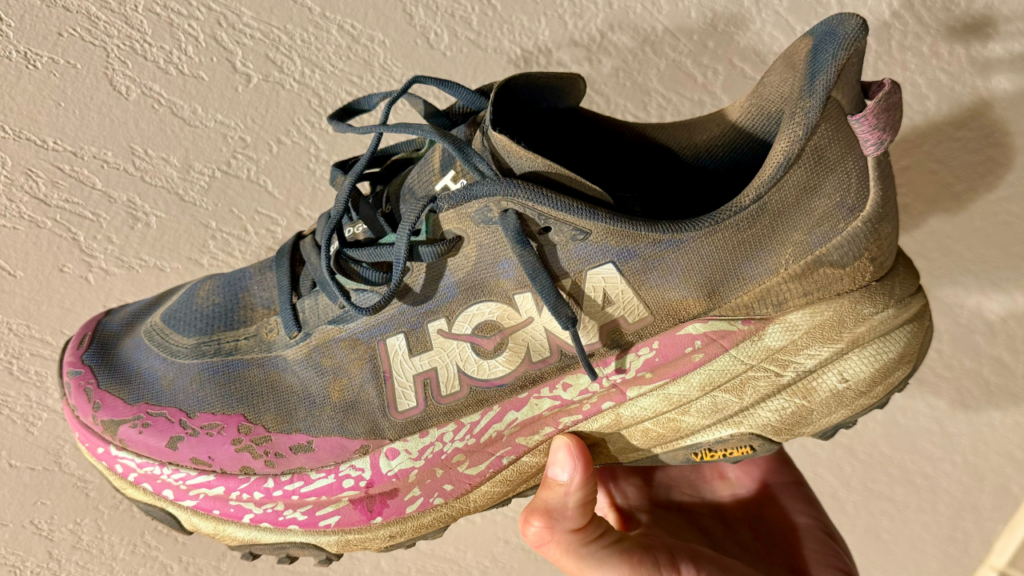
Cons
Sam: I’ve touched on a few of the cons already, but I’ll summarize here. The fit/lacing of the Hoka Speedgoat 6 is difficult for me. Again, I don’t understand how the tongue continues to be such an issue when it appears to be such an easy fix. I know multiple runners who had trouble with the tongue on the Speedgoat 5 and 6 being too short. Give us a longer tongue Hoka!
The stiffness of the shoe could be a little much for some runners, and the break in period is an honest effort. The Speedgoat 6 needs around 50 miles to start to come into their own.
Overall, the biggest let down for me was just the fact that the Hoka Speedgoat 6 doesn’t seem to be what it once was. To be clear: the Speedgoat 6 is a good shoe and worth the price for anyone who wants a one-stop option for their trail running. But, the biggest drawback is that the industry as a whole has seem to caught up to the features that made the Speedgoat 2-4 legendary.
Drew: The biggest cons of the Hoka Speedgoat 6 are the lengthy break in period and its ability to cushion bigger runners for the long haul. If you’re part mountain goat, you’ll have enough cushion for endless trail adventures. However, if you’re a big lug like me that’s just trying to have some fun in the mountains, you’ll need more cushion for the pushing. Or, er, more cushion for anything above 8-10 miles.
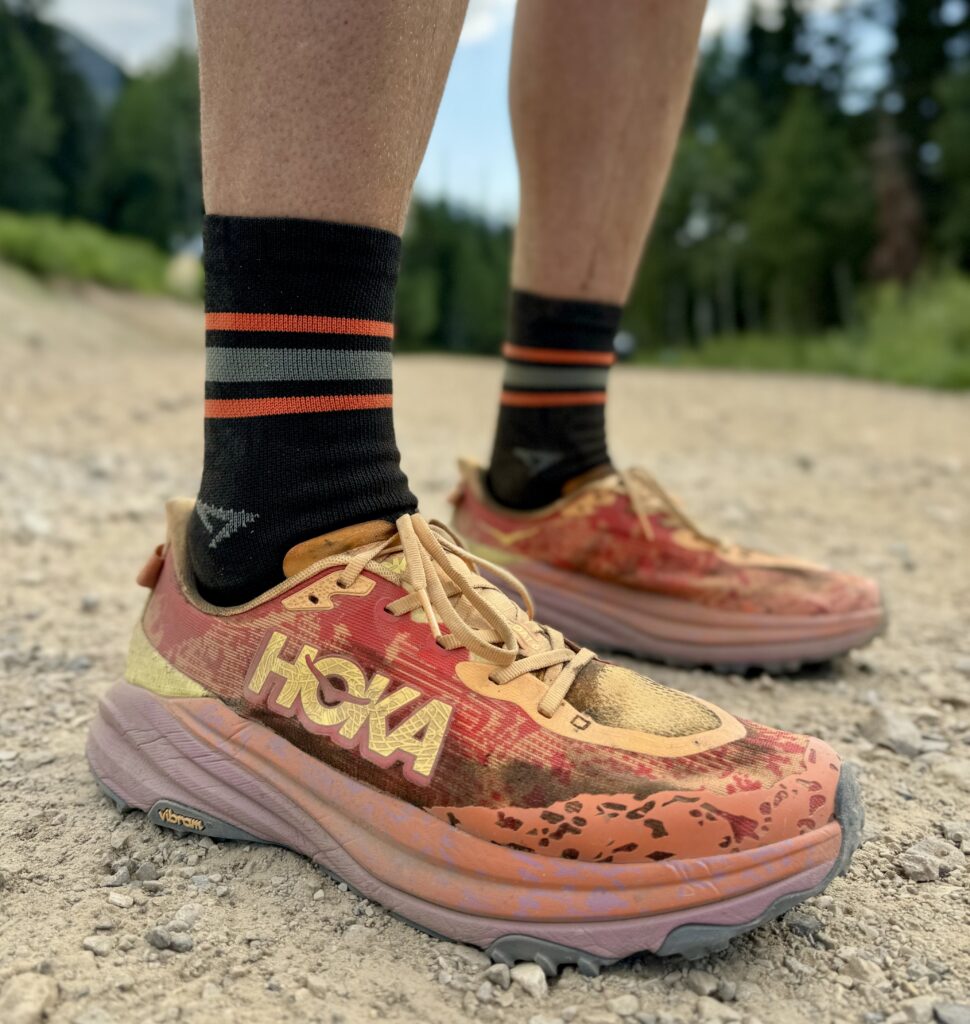
Hoka Speedgoat 6 Summary
Sam: Applause to Hoka for addressing the concerns from consumers about the Speedgoat 5. Basically, the Speedgoat line has been restored to its proper form. The Hoka Speedgoat 6 is a reliable and durable trail shoe that any runner on any trail can lace up and feel confident in. It’s hard to create the delicate balance of technicality and versatility that the Speedgoat 6 offers. A reworked upper also provides the assurance that this shoe will last its price point. Any runner should be able to get ~400 miles from this shoe.
The Hoka Speedgoat 6 is solid. A good shoe that will get the job done. It seems the days of dominance have passed, but the performance remains the same.
Drew: The Hoka Speedgoat 6 is a reliable, blue collar trail shoe. Nothing crazy innovative in any department but reliable, durable, stable, and grippy without any unnecessary features. If that’s what you want in a trail shoe, it’s time to harness that Speedgoat energy.
How does the Author Run?
Drew Whitcomb (age 42, 6’6″ 195lbs): Runs daily with a once a week rest day. Runs a lot of miles due to testing needs and a growing affinity for long-distance races. Regularly competes in marathons, half-marathons, 10k, and 5k races.
Sam Lohse (age 28, 6’0″, 170 lbs): Runs daily, sometimes morning/night doubles, with one rest day a week (typically). Hangs right around 40-50 miles a week in general unless in race-specific training. Races distances from 50K to 100 miles, almost always on the trails.
Disclosure
While Hoka did send a pair of the Hoka Speedgoat 6 to facilitate this review, the company had no involvement in this review, didn’t receive an advance look at it, and has not attempted to influence it.

